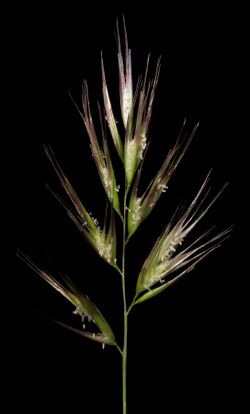Biology:Rytidosperma caespitosum
| Rytidosperma caespitosum | |
|---|---|

| |
| Scientific classification | |
| Kingdom: | Plantae |
| Clade: | Tracheophytes |
| Clade: | Angiosperms |
| Clade: | Monocots |
| Clade: | Commelinids |
| Order: | Poales |
| Family: | Poaceae |
| Genus: | Rytidosperma |
| Species: | R. caespitosum
|
| Binomial name | |
| Rytidosperma caespitosum (Gaudich.) Connor & Edgar
| |
| Synonyms[1] | |
| |
Rytidosperma caespitosum, known by various common names including common wallaby-grass, ringed wallaby-grass, and white-top, is a species of grass native to southern parts of Australia .
Description
It is a tufted perennial grass that reaches up to 90 centimetres high. Glumes are green with or without purple, and occur in a panicle of from 10 to 30 spikelets, each of which contains from four to nine individual flowers.[2][3]
Taxonomy
It was first collected from Shark Bay in Western Australia by Charles Gaudichaud-Beaupré, botanist to the expedition of Louis de Freycinet. It was published by Gaudichaud-Beaupré in 1829 under the name Danthonia caespitosa. During the 1960s and 1970s it was transferred firstly by Zotov into Notodanthonia and then by Connor & Edgar into Rytidosperma. In 1993 it was transferred into Austrodanthonia by Hans Peter Linder.[4] However, in 2010 Austrodanthonia was again submerged into a broader Rytidosperma, and all Austrodanthonia species are now considered part of the genus Rytidosperma.[5][6]
Distribution and habitat
It occurs throughout the wetter, cooler parts of southern Australia , through to hot, arid land such as Shark Bay. Its many forms span diverse habitats, variously tolerating a range of salinity and soils, including sands, loams, limestone, granite and laterite.[2][3] It is considered one of the main native pasture grasses in southern Australia[7]
Ecology
Flowering occurs in spring or summer, usually in response to rain.[3]
References
- ↑ Rytidosperma caespitosum (NSW PlantNet)
- ↑ 2.0 2.1 "Austrodanthonia caespitosa (Gaudich.) H.P.Linder". FloraBase. Western Australian Government Department of Parks and Wildlife. https://florabase.dpaw.wa.gov.au/browse/profile/17950.
- ↑ 3.0 3.1 3.2 "New South Wales Flora Online: Austrodanthonia caespitosa". Royal Botanic Gardens & Domain Trust, Sydney, Australia. http://plantnet.rbgsyd.nsw.gov.au/cgi-bin/NSWfl.pl?page=nswfl&lvl=sp&name=Austrodanthonia~caespitosa.
- ↑ "Austrodanthonia caespitosa (Gaudich.) H.P.Linder". Australian Plant Name Index (APNI), IBIS database. Centre for Plant Biodiversity Research, Australian Government. http://www.anbg.gov.au/cgi-bin/apni?taxon_id=202798.
- ↑ Linder, H. Peter; Baeza, Marcelo; Barker, Nigel P.; Galley, Chloé; Humphreys, Aelys M.; Lloyd, Kelvin M.; Orlovich, David A.; Pirie, Michael D. et al. (2010). "A Generic Classification of the Danthonioideae (Poaceae)1". Annals of the Missouri Botanical Garden 97 (3): 306–364. doi:10.3417/2009006. https://bioone.org/journals/annals-of-the-missouri-botanical-garden/volume-97/issue-3/2009006/A-Generic-Classification-of-the-Danthonioideae-Poaceaea-classinternal-link-hreffn1/10.3417/2009006.short.
- ↑ "Flora of Victoria". https://vicflora.rbg.vic.gov.au/flora/taxon/de8ffcc4-1a6d-491e-86af-4ebb7be679c3.
- ↑ Bell, Una (2008), Common native grasses of south-west WA, [Mundaring, Western Australia] [Una Bell], http://trove.nla.gov.au/work/28034620, retrieved 30 October 2016
Wikidata ☰ {{{from}}} entry
 |

